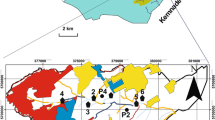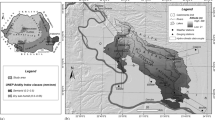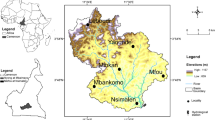Abstract
The scientific article by American hydrologists (Bolton et al. in Water balance dynamics of three small catchments in a Sub-Arctic boreal forest, 2004. https://pdfs.semanticscholar.org/c06b/7bad86cc15c5625fef0d847748bd9468f989.pdf) which is devoted to the water balance of three subarctic catchment areas, evoked great interest and encouraged to continue research in this field. The article deals with water balance elements of three small subarctic catchment areas near Fairbanks, Alaska, USA, published on the Internet (Bolton et al. 2004). The catchment area under study is Cariboo-Pocker Creek (CACPC). It is 48 km to the north of Fairbanks, Alaska. CACPC is situated in the tundra, its territory is 101.5 km2 and the soil below the surface of the ground is always frozen. Three catchment areas within CACPC are: C-2 (5.2 km2), C-3 (5.7 km2) and C-4 (11.4 km2). The catchment areas consist of 3%, 53% and 19% of permafrost, respectively. Taking into consideration the information from the American research, it turned out to be rather interesting to compare some water balance parameters presented in the article with those which are calculated with the help of a new method (Iofin in Proceedings of VI all-Russia hydrology congress, vol 1, pp 62–67, 2004). This new method is based on the linear-correlation theory and linear-correlation equation of water balance. This method has an effect in the catchment areas where hydrological observations are not carried out. Apart from this comparison, it is also of great interest to calculate the value of infiltration capacity in permafrost areas. It is also compelling to learn how accurately evapotranspiration in permafrost areas with lack of observations can be calculated with the help of rather popular Priestley–Taylor equation. The accuracy of calculation of evapotranspiration in a number of regions in the temperate zone made by Russian scientists with the help of different existing empirical formulae was under consideration. It is proved to be unsatisfactory. We had a rare opportunity to use basic data from the permafrost area and to calculate infiltration capacity and evapotranspiration. The comparison of the values of evapotranspiration shows that the calculations made with the help of the linear-correlation model (LCM) and Priestley–Taylor equation differ considerably.
Similar content being viewed by others
References
Blaney HF, Criddle WD (1950) Determining water requirements in irrigated areas from climatological and irrigation data. USDA, Washington, D.C.
Bolton WR, Hinzman L, Yoshikawa K (2004) Water balance dynamics of three small catchments in a Sub-Arctic boreal forest. https://pdfs.semanticscholar.org/c06b/7bad86cc15c5625fef0d847748bd9468f989.pdf. Accessed 2 Mar 2017
Boyarintsev EL, Gopchenko ED (1989) Surface run-off regime in small mountain catchment areas in permafrost area between periods of rain. In: Proceedings of FERHRI (Far Eastern Regional Hydrometeorological Research Institute), vol 142, pp 71–82
Boyarintsev EL, Gopchenko ED, Zagumennaya IA (2008) Genetic components of groundwater intake of rivers in the basin of Verkhnaya Kolyma. Bull Odessa State Environ Univ 6:139–146
Iofin ZK (2004) New approach to water balance components. In: Proceedings of VI all-Russia hydrology congress, vol 1, pp 62–67
Iofin ZK (2011) Quality assessment of correlation relationship between variables which consist of equiprobable values. Russian Federal State Budgetary Organization “State Hydrological Institute” (SHI), collection of research papers, vol 28, pp 101–105
Iofin ZK (2012) Improving the theory of water balance elements formation in river basins. Logos, Moscow
Thornthwaite CW (1948) An approach toward a rational classification of climate. Geogr Rev 38:55–94
Turk L (1958) Soil moisture balance. Gidrometeoizdat, Leningrad
Voyekov AI (1884) World climates in Russia. Moscow-Leningrad, pp 163–750
Author information
Authors and Affiliations
Corresponding author
Additional information
Publisher's Note
Springer Nature remains neutral with regard to jurisdictional claims in published maps and institutional affiliations.
Rights and permissions
About this article
Cite this article
Iofin, Z. Water balance of several subarctic catchment areas. Sustain. Water Resour. Manag. 6, 30 (2020). https://doi.org/10.1007/s40899-020-00387-7
Received:
Accepted:
Published:
DOI: https://doi.org/10.1007/s40899-020-00387-7




